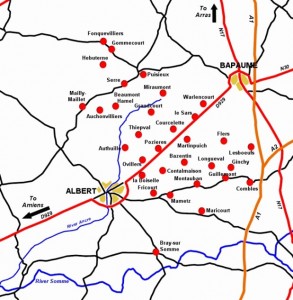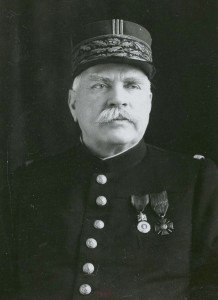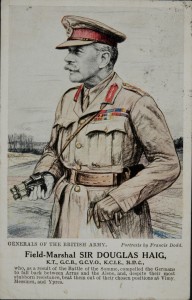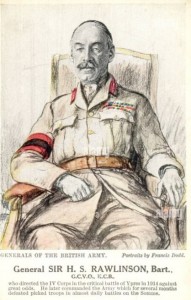
The Somme.
(WW1battlefields.co.uk)
The Commanders
The Somme was where the British and French armies met occupying a 25-mile front mostly to the north of the River Somme. The battle of 1 July 1916, was the largest operation of the Great War and started with 500,000 men, mostly volunteers of the Pals battalions. The Pals did not have the training of the British regular army whose ranks had been depleted by the summer of 1916. These men of Kitchener’s Army, the Pals, were recruited in local area drives and served with men they knew rather than being allocated to battalions to which they may have no personal affiliation. The inexperience of this new British Army meant there was little flexibility in changing plans.

General Joseph Joffre.
(Wiki Image)
The ground and the timing was not of the British Army’s choosing but the battle was insisted upon by General Joffre head of the French Army who also drove allied strategy. Haig wanted to attack in August but Joffre was not impressed by the suggestion. If the British Army did not attack in July Joffre felt the French Army who had been defending Verdun since February 1916 would no longer exist.

Field-Marshall Sir Douglas Haig.
(Postcard Image)
Haig whose position was not subordinate to Joffre had recently taken over from British Field-Marshall Sir John French. The Somme was Haig’s first campaign in command of the British Army and his leadership continues to be be the subject of considerable debate. Haig was not inclined to listen to subordinates. His tactics favored the unlimited quick breakthrough with cavalry passing through the line.

General Sir Henry Rawlinson.
(Postcard image)
Sir Henry Rawlinson was one of Haig’s senior army commanders, a subordinate, leading the British Fourth Army. Rawlinson’s command was the main British force of the Somme campaign. The Fourth Army was formed in February 1916 and eleven divisions attacked on the 1 July 1916. Rawlinson in contrast to Haig preferred the tactic of bite and hold – to pulverize the enemy, and occupy trench to trench. The tactics of Haig and Rawlinson clashed and led to strained relations.
Tags: Battle of the Somme, British Army, Command, Douglas Haig, French Army, Henry Rawlinson, Joseph Joffre, Leadership, Pals Battalions, Tactics
This entry was posted by pferguson
on Sunday, April 30th, 2023 at 3:41 pm and is filed under Snapshots of the Great War.
You can follow any responses to this entry through the RSS 2.0 feed.
You can leave a response, or trackback from your own site.
About The Author

Paul has worked with the Paradigm Motion Picture Company since 2009 as producer, historian and research specialist. Paul first met Casey and Ian WIlliams of Paradigm in April 2007 at Ieper (Ypres), Belgium when ceremonies were being held for the re-dedication of the Vimy Memorial, France.
Paul's sensitivity to film was developed at an early age seeing his first films at RCAF Zweibrucken, Germany and Sardinia. Paul returned to Canada in 1967 and was captivated by David Lean's "Lawrence of Arabia" and "Bridge on the River Kwai". Over time Paul became increasingly interested in storytelling, content development, character, direction, cinematography, narration and soundtracks.
At the University of Victoria, Paul studied and compared Japanese and Australian film and became interested in Australian film maker Peter Weir and his film "Gallipoli" (1981). Paul was inspired when he learned Weir visited the beaches, ridges and ravines of the peninsula. "Gallipoli", the film, led Paul on many journeys to sites of conflict in England, France, Belgium, Holland, Germany, Malta, Hawaii, Gallipoli, North Macedonia and Salonika.
When Paul first watched documentary filmmaker Ken Burns, "The Civil War", Paul understood how his own experience and insight could be effective and perhaps influential in film-making. Combining his knowledge of Museums and Archives, exhibitions and idea strategies with his film interests was a natural progression.
Paul thinks like a film-maker. His passion for history and storytelling brings to Paradigm an eye (and ear) to the keen and sensitive interests of; content development, the understanding of successful and relational use of collections, imagery and voice. Like Paul's favorite actor, Peter O'Toole, Paul believes in the adage “To deepen not broaden.”
While on this path Paul always remembers his grandmother whose father did not return from the Great War and how his loss shaped her life and how her experience continues to guide him.





Comments